Comprehensive Report on Cybersecurity Threats and Deep Learning
VerifiedAdded on 2022/07/28
|11
|2321
|49
Report
AI Summary
This report provides a comprehensive overview of cybersecurity threats in the modern digital landscape. It begins by defining cyber threats and their increasing prevalence, followed by a discussion of various attack types, including malware, phishing, spear phishing, Man-in-the-Middle attacks, Trojans, ransomware, and Denial of Service (DoS) and Distributed Denial of Service (DDoS) attacks. The report also identifies the sources of these threats, ranging from individual hackers to organized crime and nation-states. Furthermore, it explores the trends in cybersecurity threat detection, such as monitoring for spikes in activity, tracking access attempts, and analyzing data from multiple sources. The report then delves into the application of deep learning methods in cybersecurity, including Deep Belief Networks (DBNs), Recurrent Neural Networks (RNNs), Generative Adversarial Networks (GANs), and Recursive Neural Networks (RNNs), highlighting their potential for enhancing threat detection and prevention. The report concludes by emphasizing the importance of a collaborative approach to cybersecurity, acknowledging the complexities and the need for continuous learning and adaptation to counter the evolving threat landscape.
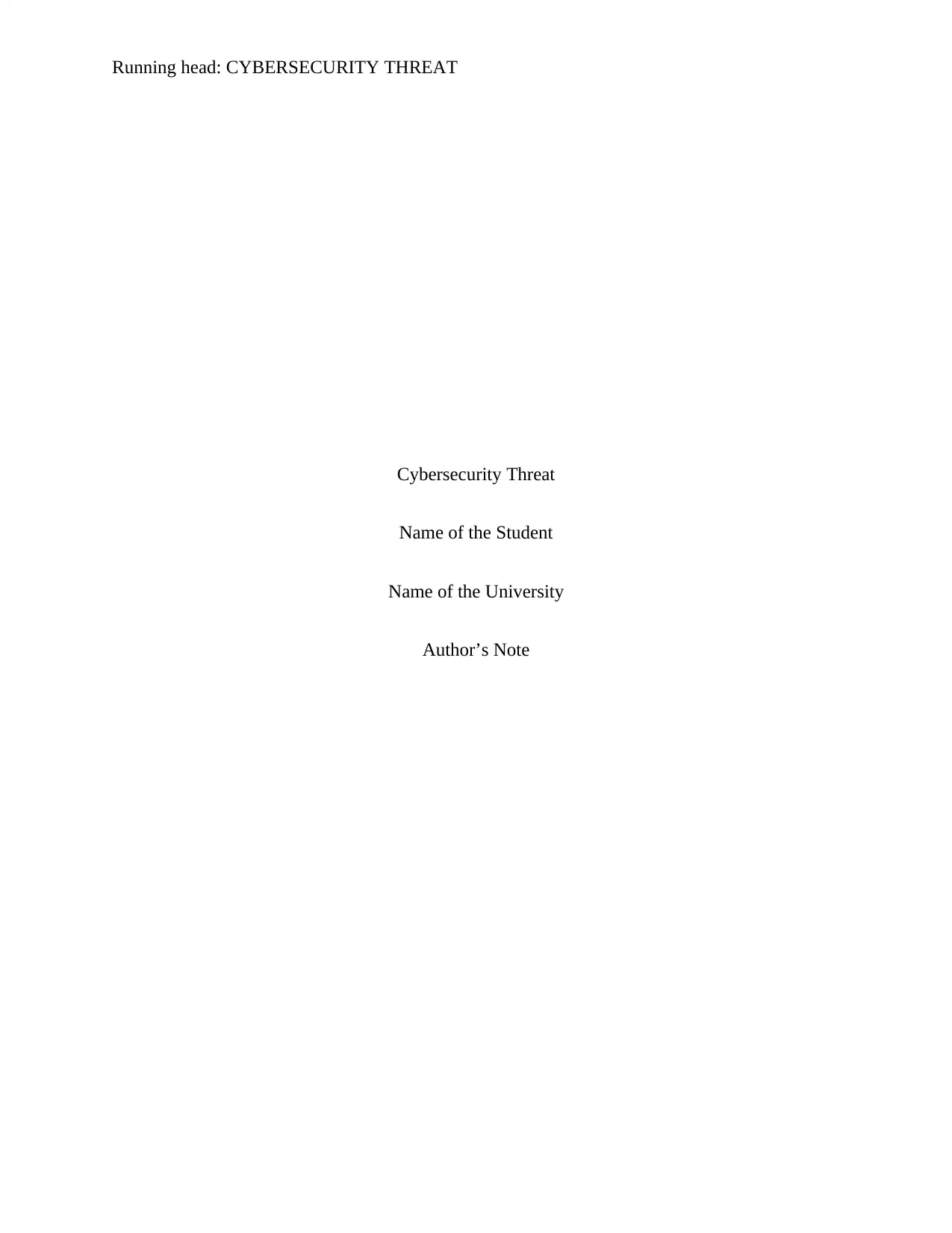
Running head: CYBERSECURITY THREAT
Cybersecurity Threat
Name of the Student
Name of the University
Author’s Note
Cybersecurity Threat
Name of the Student
Name of the University
Author’s Note
Paraphrase This Document
Need a fresh take? Get an instant paraphrase of this document with our AI Paraphraser
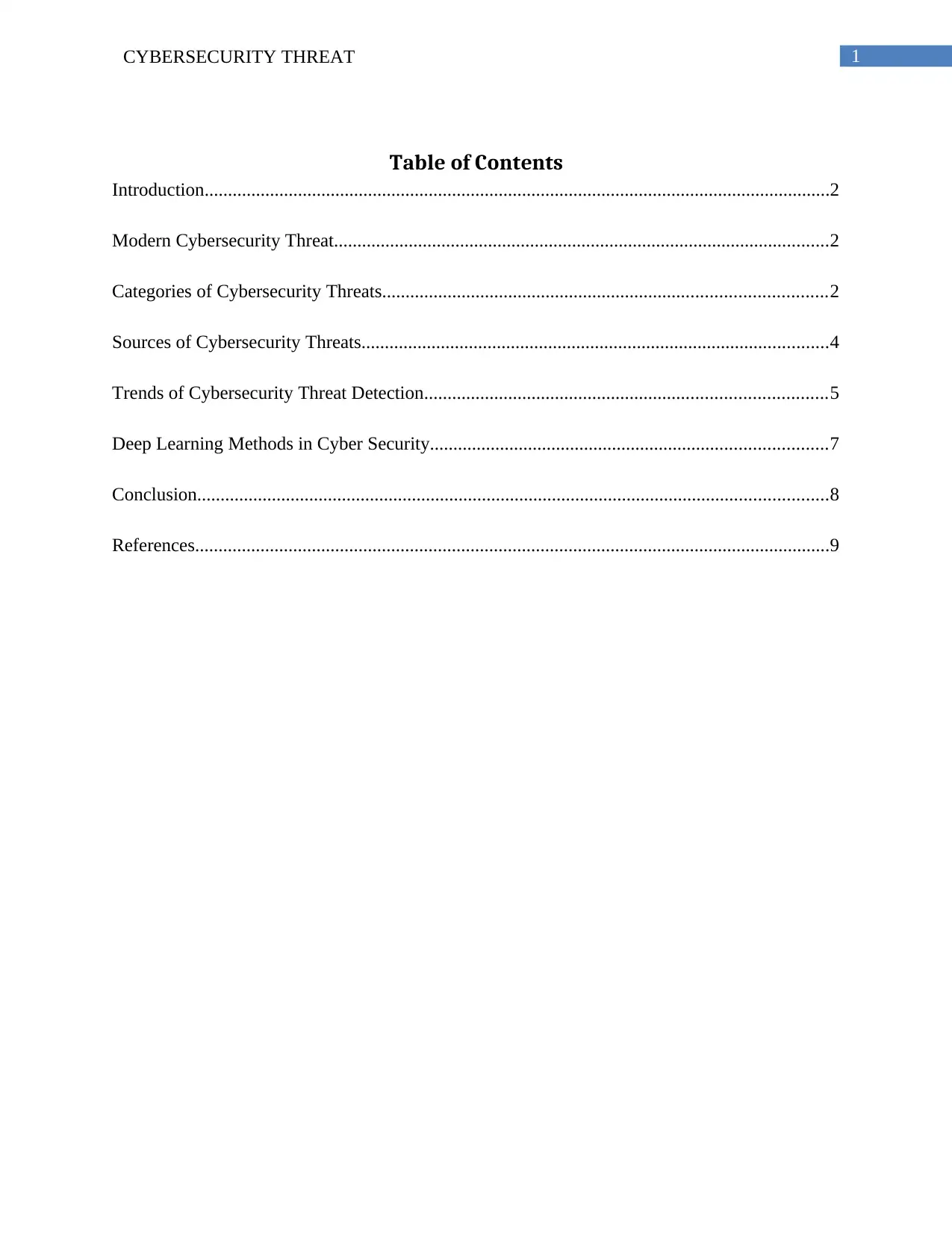
CYBERSECURITY THREAT 1
Table of Contents
Introduction......................................................................................................................................2
Modern Cybersecurity Threat..........................................................................................................2
Categories of Cybersecurity Threats...............................................................................................2
Sources of Cybersecurity Threats....................................................................................................4
Trends of Cybersecurity Threat Detection......................................................................................5
Deep Learning Methods in Cyber Security.....................................................................................7
Conclusion.......................................................................................................................................8
References........................................................................................................................................9
Table of Contents
Introduction......................................................................................................................................2
Modern Cybersecurity Threat..........................................................................................................2
Categories of Cybersecurity Threats...............................................................................................2
Sources of Cybersecurity Threats....................................................................................................4
Trends of Cybersecurity Threat Detection......................................................................................5
Deep Learning Methods in Cyber Security.....................................................................................7
Conclusion.......................................................................................................................................8
References........................................................................................................................................9
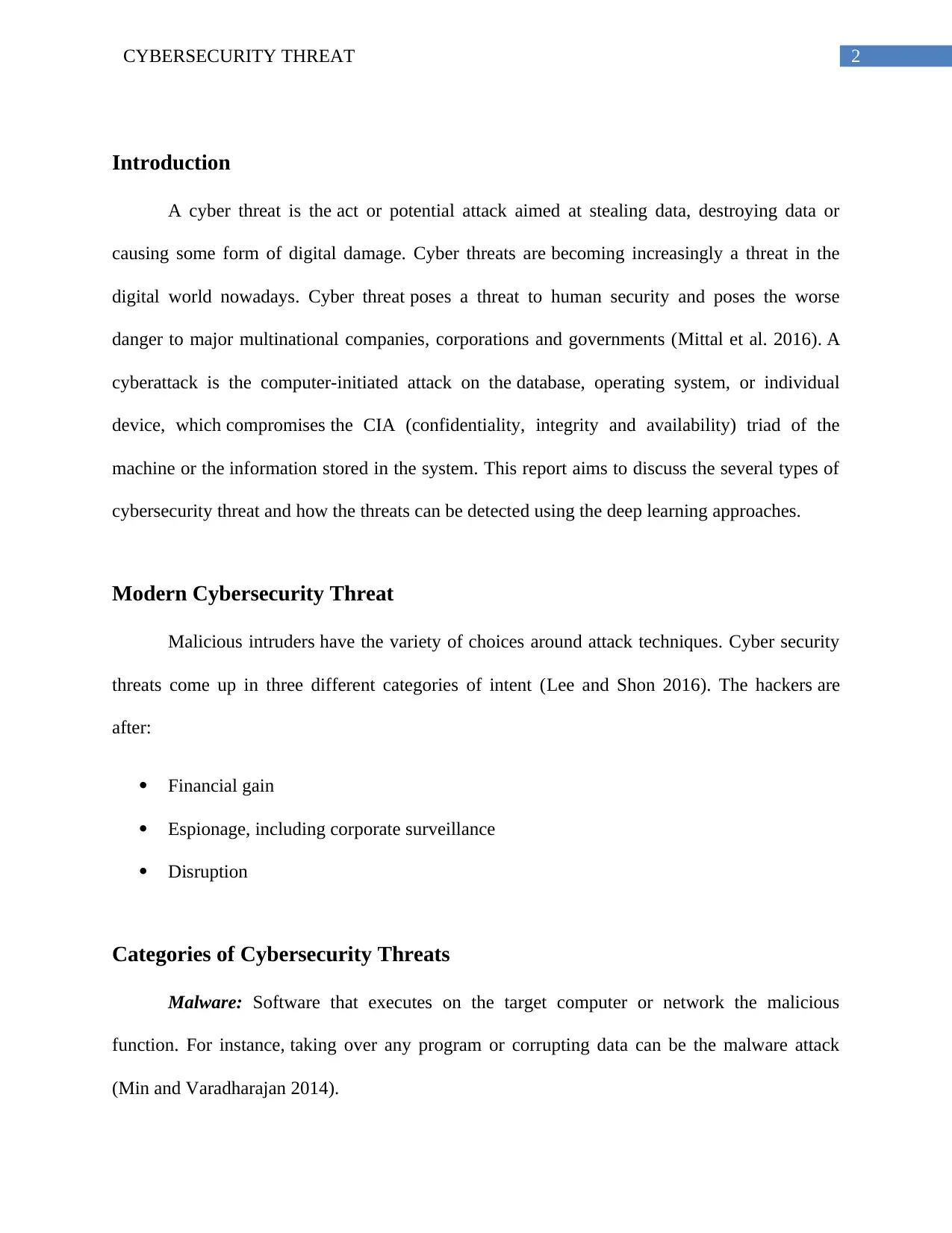
2CYBERSECURITY THREAT
Introduction
A cyber threat is the act or potential attack aimed at stealing data, destroying data or
causing some form of digital damage. Cyber threats are becoming increasingly a threat in the
digital world nowadays. Cyber threat poses a threat to human security and poses the worse
danger to major multinational companies, corporations and governments (Mittal et al. 2016). A
cyberattack is the computer-initiated attack on the database, operating system, or individual
device, which compromises the CIA (confidentiality, integrity and availability) triad of the
machine or the information stored in the system. This report aims to discuss the several types of
cybersecurity threat and how the threats can be detected using the deep learning approaches.
Modern Cybersecurity Threat
Malicious intruders have the variety of choices around attack techniques. Cyber security
threats come up in three different categories of intent (Lee and Shon 2016). The hackers are
after:
Financial gain
Espionage, including corporate surveillance
Disruption
Categories of Cybersecurity Threats
Malware: Software that executes on the target computer or network the malicious
function. For instance, taking over any program or corrupting data can be the malware attack
(Min and Varadharajan 2014).
Introduction
A cyber threat is the act or potential attack aimed at stealing data, destroying data or
causing some form of digital damage. Cyber threats are becoming increasingly a threat in the
digital world nowadays. Cyber threat poses a threat to human security and poses the worse
danger to major multinational companies, corporations and governments (Mittal et al. 2016). A
cyberattack is the computer-initiated attack on the database, operating system, or individual
device, which compromises the CIA (confidentiality, integrity and availability) triad of the
machine or the information stored in the system. This report aims to discuss the several types of
cybersecurity threat and how the threats can be detected using the deep learning approaches.
Modern Cybersecurity Threat
Malicious intruders have the variety of choices around attack techniques. Cyber security
threats come up in three different categories of intent (Lee and Shon 2016). The hackers are
after:
Financial gain
Espionage, including corporate surveillance
Disruption
Categories of Cybersecurity Threats
Malware: Software that executes on the target computer or network the malicious
function. For instance, taking over any program or corrupting data can be the malware attack
(Min and Varadharajan 2014).
⊘ This is a preview!⊘
Do you want full access?
Subscribe today to unlock all pages.

Trusted by 1+ million students worldwide
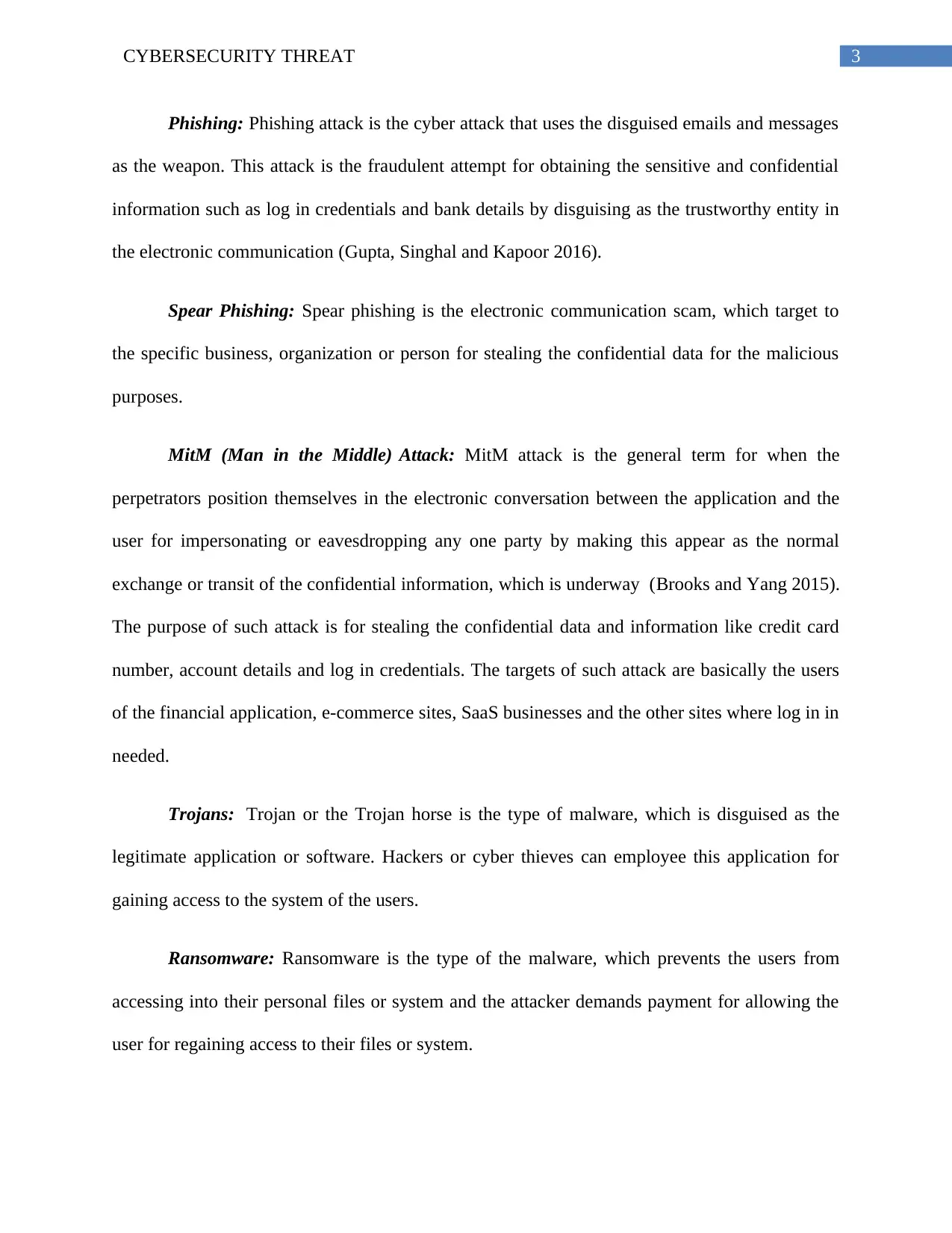
3CYBERSECURITY THREAT
Phishing: Phishing attack is the cyber attack that uses the disguised emails and messages
as the weapon. This attack is the fraudulent attempt for obtaining the sensitive and confidential
information such as log in credentials and bank details by disguising as the trustworthy entity in
the electronic communication (Gupta, Singhal and Kapoor 2016).
Spear Phishing: Spear phishing is the electronic communication scam, which target to
the specific business, organization or person for stealing the confidential data for the malicious
purposes.
MitM (Man in the Middle) Attack: MitM attack is the general term for when the
perpetrators position themselves in the electronic conversation between the application and the
user for impersonating or eavesdropping any one party by making this appear as the normal
exchange or transit of the confidential information, which is underway (Brooks and Yang 2015).
The purpose of such attack is for stealing the confidential data and information like credit card
number, account details and log in credentials. The targets of such attack are basically the users
of the financial application, e-commerce sites, SaaS businesses and the other sites where log in in
needed.
Trojans: Trojan or the Trojan horse is the type of malware, which is disguised as the
legitimate application or software. Hackers or cyber thieves can employee this application for
gaining access to the system of the users.
Ransomware: Ransomware is the type of the malware, which prevents the users from
accessing into their personal files or system and the attacker demands payment for allowing the
user for regaining access to their files or system.
Phishing: Phishing attack is the cyber attack that uses the disguised emails and messages
as the weapon. This attack is the fraudulent attempt for obtaining the sensitive and confidential
information such as log in credentials and bank details by disguising as the trustworthy entity in
the electronic communication (Gupta, Singhal and Kapoor 2016).
Spear Phishing: Spear phishing is the electronic communication scam, which target to
the specific business, organization or person for stealing the confidential data for the malicious
purposes.
MitM (Man in the Middle) Attack: MitM attack is the general term for when the
perpetrators position themselves in the electronic conversation between the application and the
user for impersonating or eavesdropping any one party by making this appear as the normal
exchange or transit of the confidential information, which is underway (Brooks and Yang 2015).
The purpose of such attack is for stealing the confidential data and information like credit card
number, account details and log in credentials. The targets of such attack are basically the users
of the financial application, e-commerce sites, SaaS businesses and the other sites where log in in
needed.
Trojans: Trojan or the Trojan horse is the type of malware, which is disguised as the
legitimate application or software. Hackers or cyber thieves can employee this application for
gaining access to the system of the users.
Ransomware: Ransomware is the type of the malware, which prevents the users from
accessing into their personal files or system and the attacker demands payment for allowing the
user for regaining access to their files or system.
Paraphrase This Document
Need a fresh take? Get an instant paraphrase of this document with our AI Paraphraser
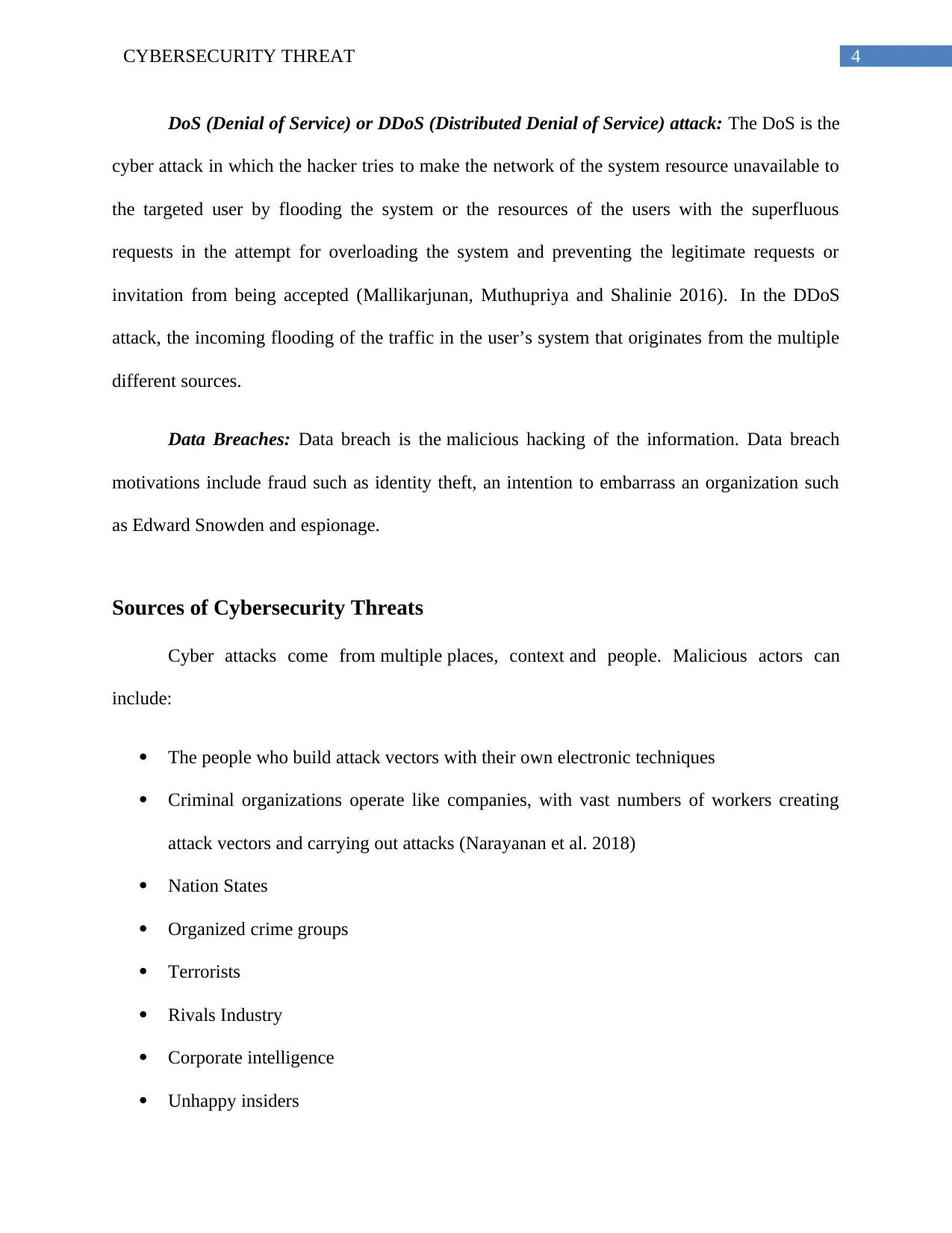
4CYBERSECURITY THREAT
DoS (Denial of Service) or DDoS (Distributed Denial of Service) attack: The DoS is the
cyber attack in which the hacker tries to make the network of the system resource unavailable to
the targeted user by flooding the system or the resources of the users with the superfluous
requests in the attempt for overloading the system and preventing the legitimate requests or
invitation from being accepted (Mallikarjunan, Muthupriya and Shalinie 2016). In the DDoS
attack, the incoming flooding of the traffic in the user’s system that originates from the multiple
different sources.
Data Breaches: Data breach is the malicious hacking of the information. Data breach
motivations include fraud such as identity theft, an intention to embarrass an organization such
as Edward Snowden and espionage.
Sources of Cybersecurity Threats
Cyber attacks come from multiple places, context and people. Malicious actors can
include:
The people who build attack vectors with their own electronic techniques
Criminal organizations operate like companies, with vast numbers of workers creating
attack vectors and carrying out attacks (Narayanan et al. 2018)
Nation States
Organized crime groups
Terrorists
Rivals Industry
Corporate intelligence
Unhappy insiders
DoS (Denial of Service) or DDoS (Distributed Denial of Service) attack: The DoS is the
cyber attack in which the hacker tries to make the network of the system resource unavailable to
the targeted user by flooding the system or the resources of the users with the superfluous
requests in the attempt for overloading the system and preventing the legitimate requests or
invitation from being accepted (Mallikarjunan, Muthupriya and Shalinie 2016). In the DDoS
attack, the incoming flooding of the traffic in the user’s system that originates from the multiple
different sources.
Data Breaches: Data breach is the malicious hacking of the information. Data breach
motivations include fraud such as identity theft, an intention to embarrass an organization such
as Edward Snowden and espionage.
Sources of Cybersecurity Threats
Cyber attacks come from multiple places, context and people. Malicious actors can
include:
The people who build attack vectors with their own electronic techniques
Criminal organizations operate like companies, with vast numbers of workers creating
attack vectors and carrying out attacks (Narayanan et al. 2018)
Nation States
Organized crime groups
Terrorists
Rivals Industry
Corporate intelligence
Unhappy insiders
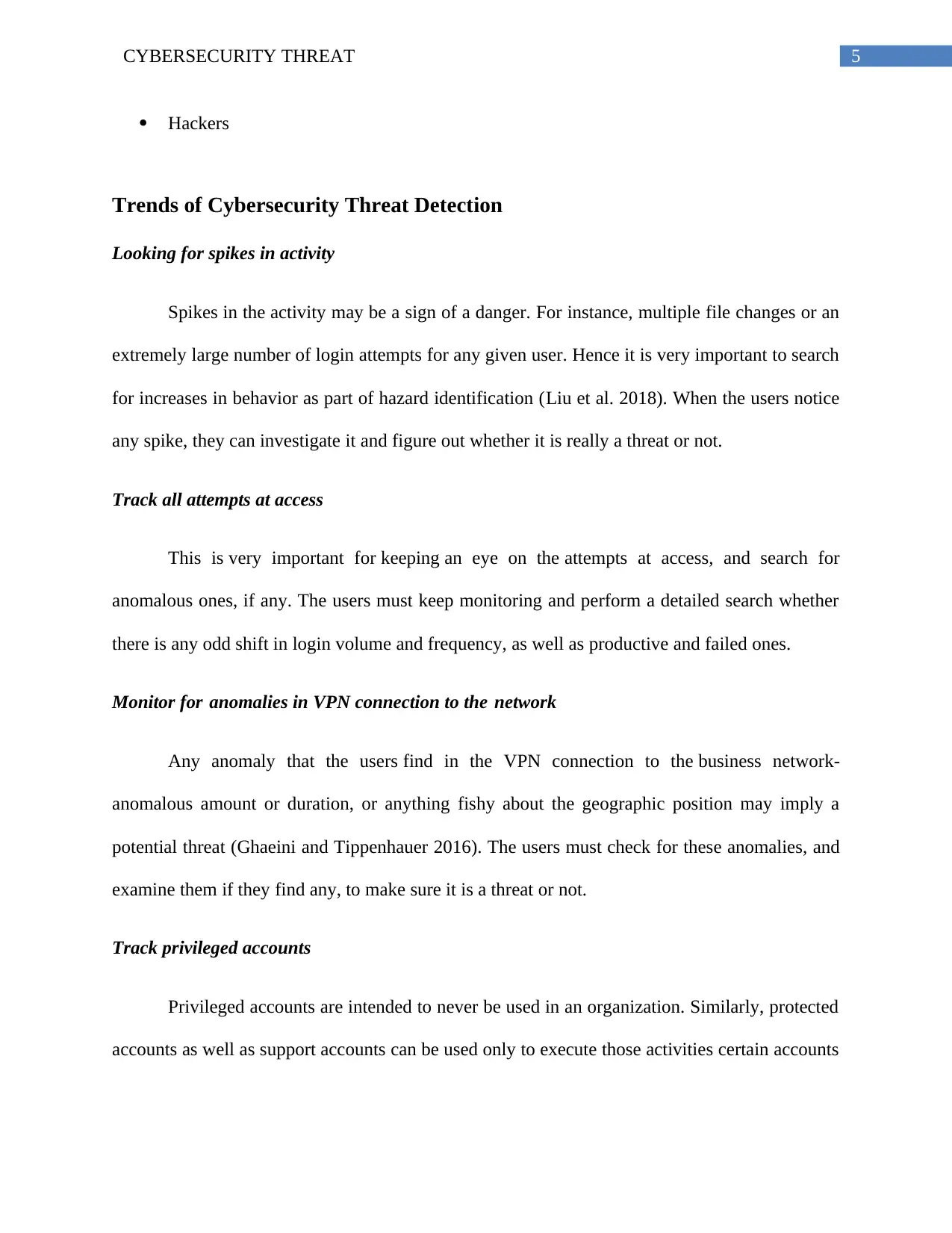
5CYBERSECURITY THREAT
Hackers
Trends of Cybersecurity Threat Detection
Looking for spikes in activity
Spikes in the activity may be a sign of a danger. For instance, multiple file changes or an
extremely large number of login attempts for any given user. Hence it is very important to search
for increases in behavior as part of hazard identification (Liu et al. 2018). When the users notice
any spike, they can investigate it and figure out whether it is really a threat or not.
Track all attempts at access
This is very important for keeping an eye on the attempts at access, and search for
anomalous ones, if any. The users must keep monitoring and perform a detailed search whether
there is any odd shift in login volume and frequency, as well as productive and failed ones.
Monitor for anomalies in VPN connection to the network
Any anomaly that the users find in the VPN connection to the business network-
anomalous amount or duration, or anything fishy about the geographic position may imply a
potential threat (Ghaeini and Tippenhauer 2016). The users must check for these anomalies, and
examine them if they find any, to make sure it is a threat or not.
Track privileged accounts
Privileged accounts are intended to never be used in an organization. Similarly, protected
accounts as well as support accounts can be used only to execute those activities certain accounts
Hackers
Trends of Cybersecurity Threat Detection
Looking for spikes in activity
Spikes in the activity may be a sign of a danger. For instance, multiple file changes or an
extremely large number of login attempts for any given user. Hence it is very important to search
for increases in behavior as part of hazard identification (Liu et al. 2018). When the users notice
any spike, they can investigate it and figure out whether it is really a threat or not.
Track all attempts at access
This is very important for keeping an eye on the attempts at access, and search for
anomalous ones, if any. The users must keep monitoring and perform a detailed search whether
there is any odd shift in login volume and frequency, as well as productive and failed ones.
Monitor for anomalies in VPN connection to the network
Any anomaly that the users find in the VPN connection to the business network-
anomalous amount or duration, or anything fishy about the geographic position may imply a
potential threat (Ghaeini and Tippenhauer 2016). The users must check for these anomalies, and
examine them if they find any, to make sure it is a threat or not.
Track privileged accounts
Privileged accounts are intended to never be used in an organization. Similarly, protected
accounts as well as support accounts can be used only to execute those activities certain accounts
⊘ This is a preview!⊘
Do you want full access?
Subscribe today to unlock all pages.

Trusted by 1+ million students worldwide
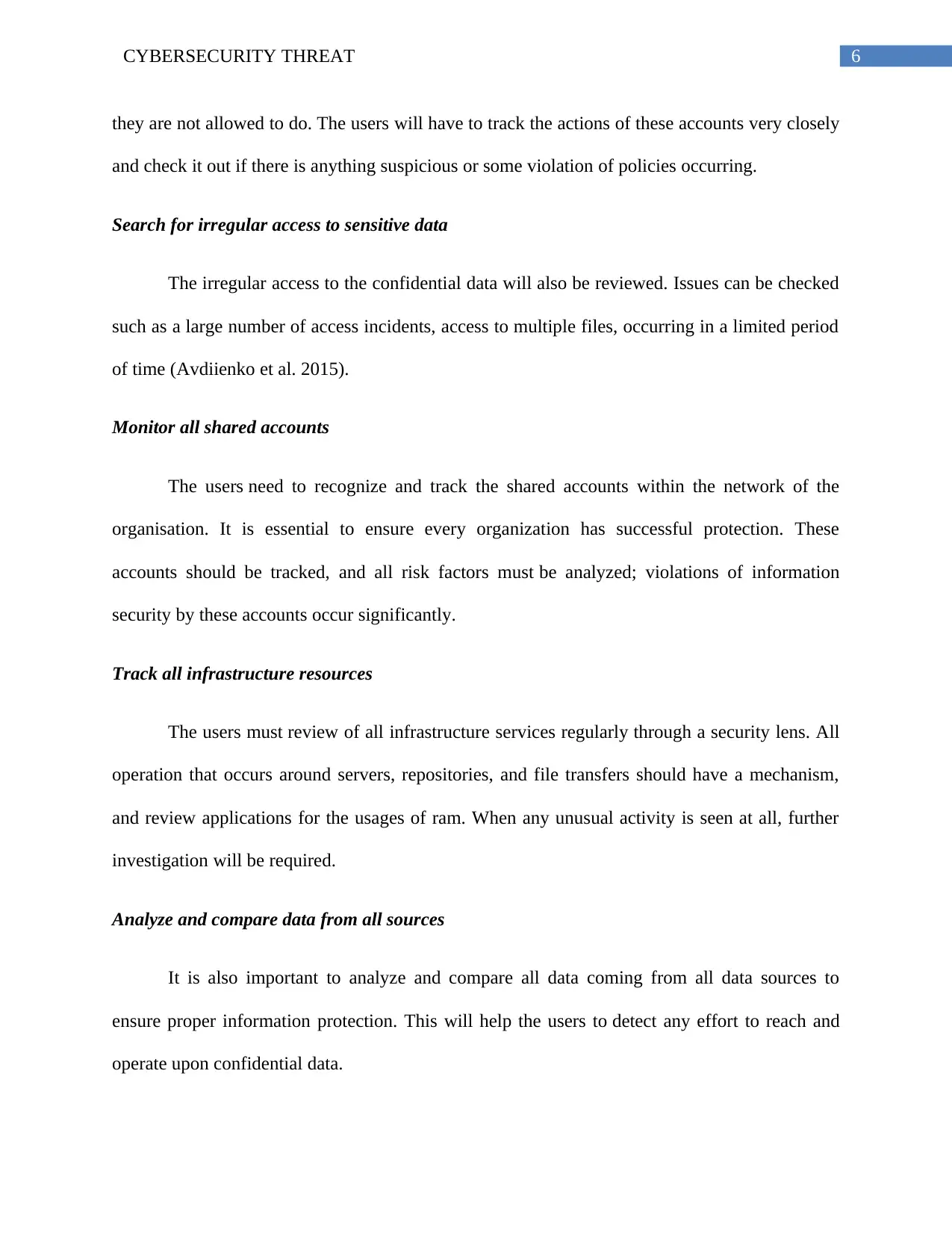
6CYBERSECURITY THREAT
they are not allowed to do. The users will have to track the actions of these accounts very closely
and check it out if there is anything suspicious or some violation of policies occurring.
Search for irregular access to sensitive data
The irregular access to the confidential data will also be reviewed. Issues can be checked
such as a large number of access incidents, access to multiple files, occurring in a limited period
of time (Avdiienko et al. 2015).
Monitor all shared accounts
The users need to recognize and track the shared accounts within the network of the
organisation. It is essential to ensure every organization has successful protection. These
accounts should be tracked, and all risk factors must be analyzed; violations of information
security by these accounts occur significantly.
Track all infrastructure resources
The users must review of all infrastructure services regularly through a security lens. All
operation that occurs around servers, repositories, and file transfers should have a mechanism,
and review applications for the usages of ram. When any unusual activity is seen at all, further
investigation will be required.
Analyze and compare data from all sources
It is also important to analyze and compare all data coming from all data sources to
ensure proper information protection. This will help the users to detect any effort to reach and
operate upon confidential data.
they are not allowed to do. The users will have to track the actions of these accounts very closely
and check it out if there is anything suspicious or some violation of policies occurring.
Search for irregular access to sensitive data
The irregular access to the confidential data will also be reviewed. Issues can be checked
such as a large number of access incidents, access to multiple files, occurring in a limited period
of time (Avdiienko et al. 2015).
Monitor all shared accounts
The users need to recognize and track the shared accounts within the network of the
organisation. It is essential to ensure every organization has successful protection. These
accounts should be tracked, and all risk factors must be analyzed; violations of information
security by these accounts occur significantly.
Track all infrastructure resources
The users must review of all infrastructure services regularly through a security lens. All
operation that occurs around servers, repositories, and file transfers should have a mechanism,
and review applications for the usages of ram. When any unusual activity is seen at all, further
investigation will be required.
Analyze and compare data from all sources
It is also important to analyze and compare all data coming from all data sources to
ensure proper information protection. This will help the users to detect any effort to reach and
operate upon confidential data.
Paraphrase This Document
Need a fresh take? Get an instant paraphrase of this document with our AI Paraphraser
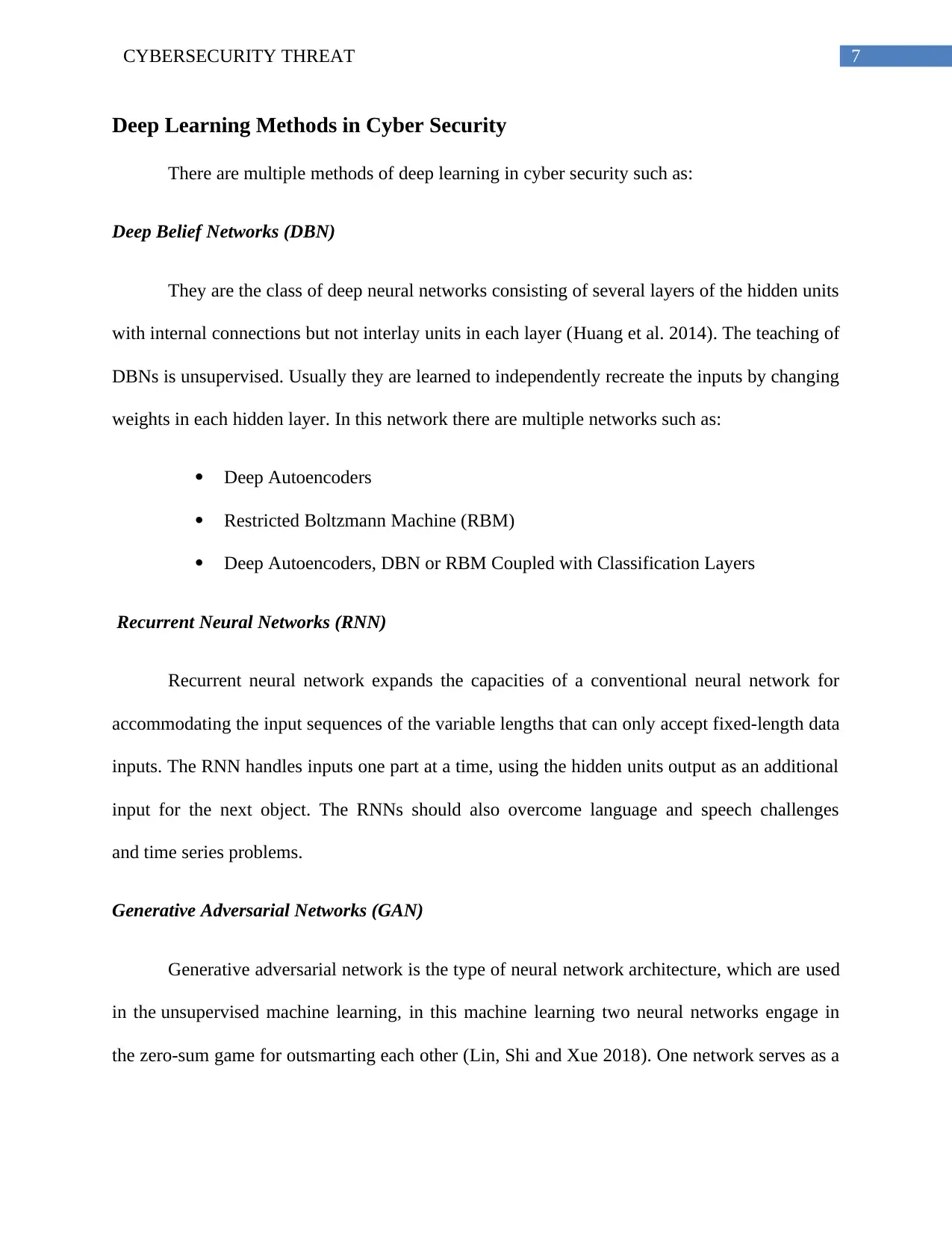
7CYBERSECURITY THREAT
Deep Learning Methods in Cyber Security
There are multiple methods of deep learning in cyber security such as:
Deep Belief Networks (DBN)
They are the class of deep neural networks consisting of several layers of the hidden units
with internal connections but not interlay units in each layer (Huang et al. 2014). The teaching of
DBNs is unsupervised. Usually they are learned to independently recreate the inputs by changing
weights in each hidden layer. In this network there are multiple networks such as:
Deep Autoencoders
Restricted Boltzmann Machine (RBM)
Deep Autoencoders, DBN or RBM Coupled with Classification Layers
Recurrent Neural Networks (RNN)
Recurrent neural network expands the capacities of a conventional neural network for
accommodating the input sequences of the variable lengths that can only accept fixed-length data
inputs. The RNN handles inputs one part at a time, using the hidden units output as an additional
input for the next object. The RNNs should also overcome language and speech challenges
and time series problems.
Generative Adversarial Networks (GAN)
Generative adversarial network is the type of neural network architecture, which are used
in the unsupervised machine learning, in this machine learning two neural networks engage in
the zero-sum game for outsmarting each other (Lin, Shi and Xue 2018). One network serves as a
Deep Learning Methods in Cyber Security
There are multiple methods of deep learning in cyber security such as:
Deep Belief Networks (DBN)
They are the class of deep neural networks consisting of several layers of the hidden units
with internal connections but not interlay units in each layer (Huang et al. 2014). The teaching of
DBNs is unsupervised. Usually they are learned to independently recreate the inputs by changing
weights in each hidden layer. In this network there are multiple networks such as:
Deep Autoencoders
Restricted Boltzmann Machine (RBM)
Deep Autoencoders, DBN or RBM Coupled with Classification Layers
Recurrent Neural Networks (RNN)
Recurrent neural network expands the capacities of a conventional neural network for
accommodating the input sequences of the variable lengths that can only accept fixed-length data
inputs. The RNN handles inputs one part at a time, using the hidden units output as an additional
input for the next object. The RNNs should also overcome language and speech challenges
and time series problems.
Generative Adversarial Networks (GAN)
Generative adversarial network is the type of neural network architecture, which are used
in the unsupervised machine learning, in this machine learning two neural networks engage in
the zero-sum game for outsmarting each other (Lin, Shi and Xue 2018). One network serves as a
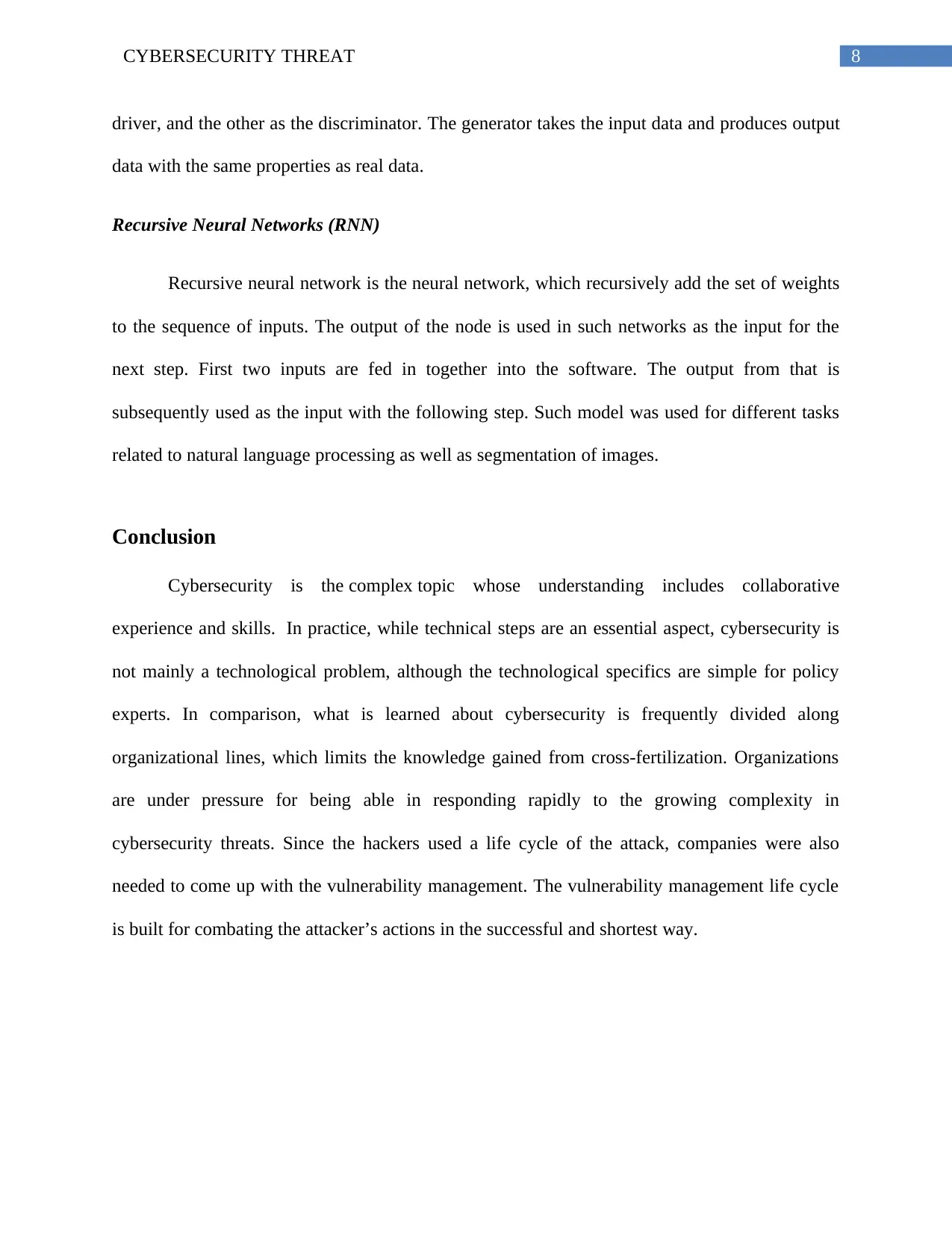
8CYBERSECURITY THREAT
driver, and the other as the discriminator. The generator takes the input data and produces output
data with the same properties as real data.
Recursive Neural Networks (RNN)
Recursive neural network is the neural network, which recursively add the set of weights
to the sequence of inputs. The output of the node is used in such networks as the input for the
next step. First two inputs are fed in together into the software. The output from that is
subsequently used as the input with the following step. Such model was used for different tasks
related to natural language processing as well as segmentation of images.
Conclusion
Cybersecurity is the complex topic whose understanding includes collaborative
experience and skills. In practice, while technical steps are an essential aspect, cybersecurity is
not mainly a technological problem, although the technological specifics are simple for policy
experts. In comparison, what is learned about cybersecurity is frequently divided along
organizational lines, which limits the knowledge gained from cross-fertilization. Organizations
are under pressure for being able in responding rapidly to the growing complexity in
cybersecurity threats. Since the hackers used a life cycle of the attack, companies were also
needed to come up with the vulnerability management. The vulnerability management life cycle
is built for combating the attacker’s actions in the successful and shortest way.
driver, and the other as the discriminator. The generator takes the input data and produces output
data with the same properties as real data.
Recursive Neural Networks (RNN)
Recursive neural network is the neural network, which recursively add the set of weights
to the sequence of inputs. The output of the node is used in such networks as the input for the
next step. First two inputs are fed in together into the software. The output from that is
subsequently used as the input with the following step. Such model was used for different tasks
related to natural language processing as well as segmentation of images.
Conclusion
Cybersecurity is the complex topic whose understanding includes collaborative
experience and skills. In practice, while technical steps are an essential aspect, cybersecurity is
not mainly a technological problem, although the technological specifics are simple for policy
experts. In comparison, what is learned about cybersecurity is frequently divided along
organizational lines, which limits the knowledge gained from cross-fertilization. Organizations
are under pressure for being able in responding rapidly to the growing complexity in
cybersecurity threats. Since the hackers used a life cycle of the attack, companies were also
needed to come up with the vulnerability management. The vulnerability management life cycle
is built for combating the attacker’s actions in the successful and shortest way.
⊘ This is a preview!⊘
Do you want full access?
Subscribe today to unlock all pages.

Trusted by 1+ million students worldwide
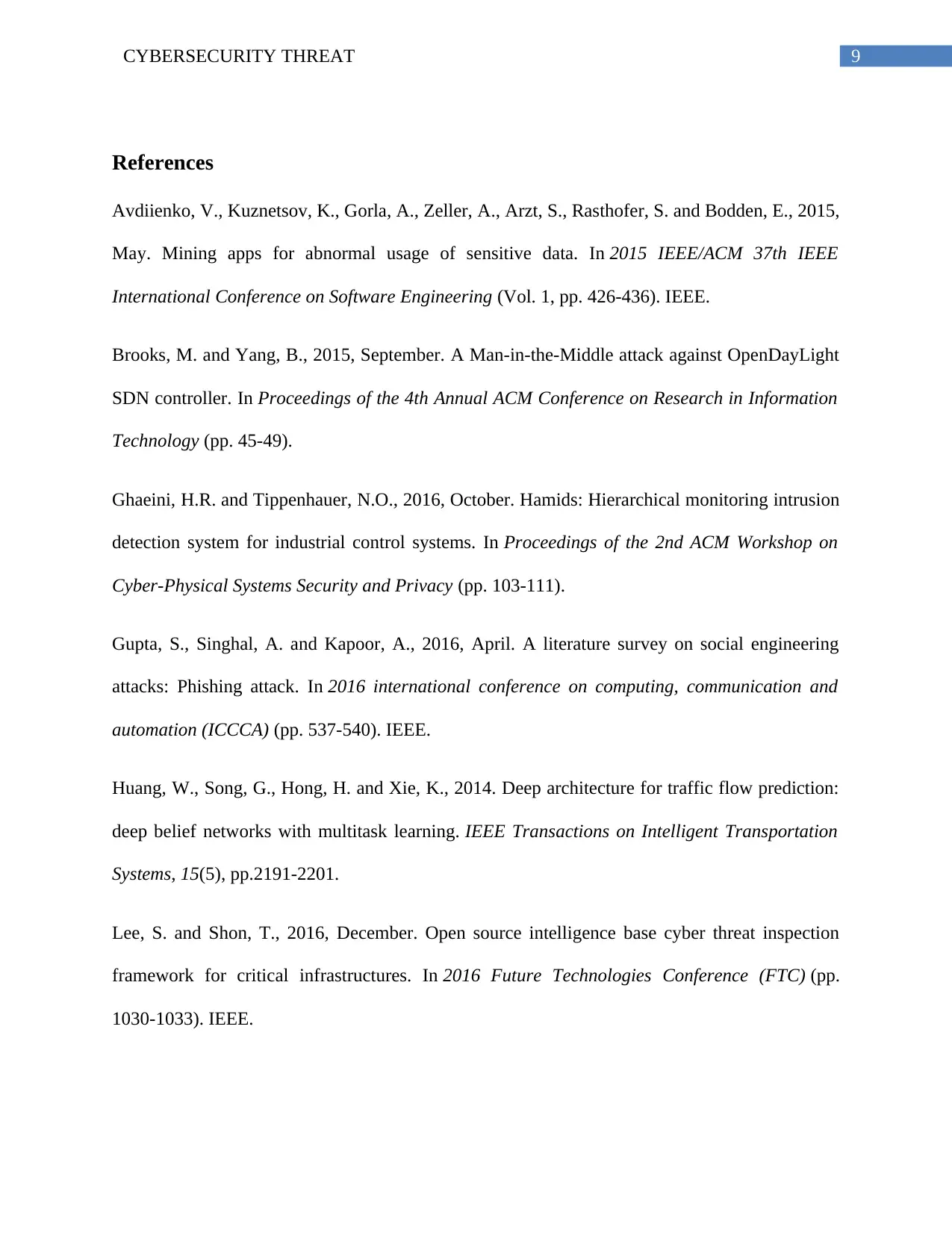
9CYBERSECURITY THREAT
References
Avdiienko, V., Kuznetsov, K., Gorla, A., Zeller, A., Arzt, S., Rasthofer, S. and Bodden, E., 2015,
May. Mining apps for abnormal usage of sensitive data. In 2015 IEEE/ACM 37th IEEE
International Conference on Software Engineering (Vol. 1, pp. 426-436). IEEE.
Brooks, M. and Yang, B., 2015, September. A Man-in-the-Middle attack against OpenDayLight
SDN controller. In Proceedings of the 4th Annual ACM Conference on Research in Information
Technology (pp. 45-49).
Ghaeini, H.R. and Tippenhauer, N.O., 2016, October. Hamids: Hierarchical monitoring intrusion
detection system for industrial control systems. In Proceedings of the 2nd ACM Workshop on
Cyber-Physical Systems Security and Privacy (pp. 103-111).
Gupta, S., Singhal, A. and Kapoor, A., 2016, April. A literature survey on social engineering
attacks: Phishing attack. In 2016 international conference on computing, communication and
automation (ICCCA) (pp. 537-540). IEEE.
Huang, W., Song, G., Hong, H. and Xie, K., 2014. Deep architecture for traffic flow prediction:
deep belief networks with multitask learning. IEEE Transactions on Intelligent Transportation
Systems, 15(5), pp.2191-2201.
Lee, S. and Shon, T., 2016, December. Open source intelligence base cyber threat inspection
framework for critical infrastructures. In 2016 Future Technologies Conference (FTC) (pp.
1030-1033). IEEE.
References
Avdiienko, V., Kuznetsov, K., Gorla, A., Zeller, A., Arzt, S., Rasthofer, S. and Bodden, E., 2015,
May. Mining apps for abnormal usage of sensitive data. In 2015 IEEE/ACM 37th IEEE
International Conference on Software Engineering (Vol. 1, pp. 426-436). IEEE.
Brooks, M. and Yang, B., 2015, September. A Man-in-the-Middle attack against OpenDayLight
SDN controller. In Proceedings of the 4th Annual ACM Conference on Research in Information
Technology (pp. 45-49).
Ghaeini, H.R. and Tippenhauer, N.O., 2016, October. Hamids: Hierarchical monitoring intrusion
detection system for industrial control systems. In Proceedings of the 2nd ACM Workshop on
Cyber-Physical Systems Security and Privacy (pp. 103-111).
Gupta, S., Singhal, A. and Kapoor, A., 2016, April. A literature survey on social engineering
attacks: Phishing attack. In 2016 international conference on computing, communication and
automation (ICCCA) (pp. 537-540). IEEE.
Huang, W., Song, G., Hong, H. and Xie, K., 2014. Deep architecture for traffic flow prediction:
deep belief networks with multitask learning. IEEE Transactions on Intelligent Transportation
Systems, 15(5), pp.2191-2201.
Lee, S. and Shon, T., 2016, December. Open source intelligence base cyber threat inspection
framework for critical infrastructures. In 2016 Future Technologies Conference (FTC) (pp.
1030-1033). IEEE.
Paraphrase This Document
Need a fresh take? Get an instant paraphrase of this document with our AI Paraphraser
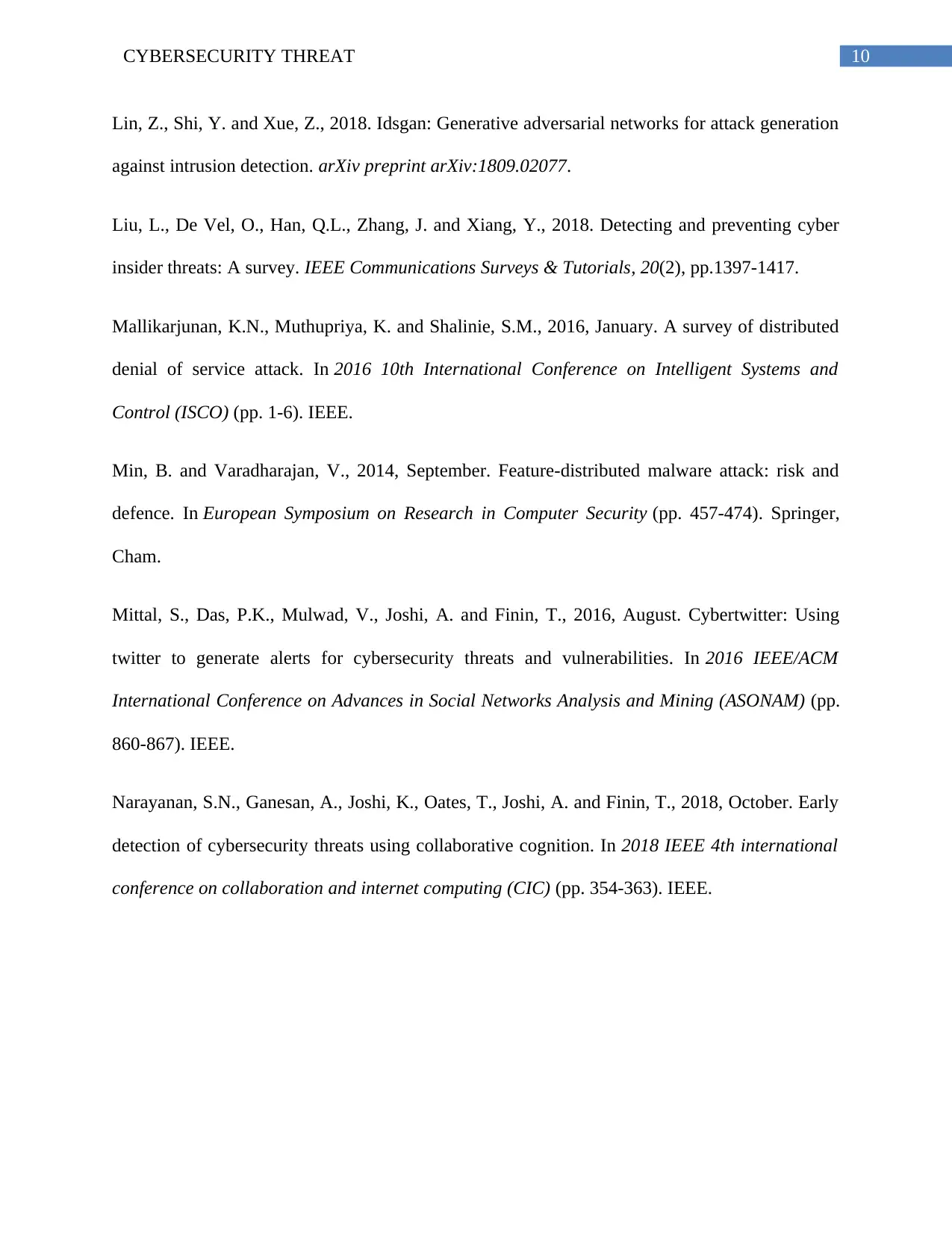
10CYBERSECURITY THREAT
Lin, Z., Shi, Y. and Xue, Z., 2018. Idsgan: Generative adversarial networks for attack generation
against intrusion detection. arXiv preprint arXiv:1809.02077.
Liu, L., De Vel, O., Han, Q.L., Zhang, J. and Xiang, Y., 2018. Detecting and preventing cyber
insider threats: A survey. IEEE Communications Surveys & Tutorials, 20(2), pp.1397-1417.
Mallikarjunan, K.N., Muthupriya, K. and Shalinie, S.M., 2016, January. A survey of distributed
denial of service attack. In 2016 10th International Conference on Intelligent Systems and
Control (ISCO) (pp. 1-6). IEEE.
Min, B. and Varadharajan, V., 2014, September. Feature-distributed malware attack: risk and
defence. In European Symposium on Research in Computer Security (pp. 457-474). Springer,
Cham.
Mittal, S., Das, P.K., Mulwad, V., Joshi, A. and Finin, T., 2016, August. Cybertwitter: Using
twitter to generate alerts for cybersecurity threats and vulnerabilities. In 2016 IEEE/ACM
International Conference on Advances in Social Networks Analysis and Mining (ASONAM) (pp.
860-867). IEEE.
Narayanan, S.N., Ganesan, A., Joshi, K., Oates, T., Joshi, A. and Finin, T., 2018, October. Early
detection of cybersecurity threats using collaborative cognition. In 2018 IEEE 4th international
conference on collaboration and internet computing (CIC) (pp. 354-363). IEEE.
Lin, Z., Shi, Y. and Xue, Z., 2018. Idsgan: Generative adversarial networks for attack generation
against intrusion detection. arXiv preprint arXiv:1809.02077.
Liu, L., De Vel, O., Han, Q.L., Zhang, J. and Xiang, Y., 2018. Detecting and preventing cyber
insider threats: A survey. IEEE Communications Surveys & Tutorials, 20(2), pp.1397-1417.
Mallikarjunan, K.N., Muthupriya, K. and Shalinie, S.M., 2016, January. A survey of distributed
denial of service attack. In 2016 10th International Conference on Intelligent Systems and
Control (ISCO) (pp. 1-6). IEEE.
Min, B. and Varadharajan, V., 2014, September. Feature-distributed malware attack: risk and
defence. In European Symposium on Research in Computer Security (pp. 457-474). Springer,
Cham.
Mittal, S., Das, P.K., Mulwad, V., Joshi, A. and Finin, T., 2016, August. Cybertwitter: Using
twitter to generate alerts for cybersecurity threats and vulnerabilities. In 2016 IEEE/ACM
International Conference on Advances in Social Networks Analysis and Mining (ASONAM) (pp.
860-867). IEEE.
Narayanan, S.N., Ganesan, A., Joshi, K., Oates, T., Joshi, A. and Finin, T., 2018, October. Early
detection of cybersecurity threats using collaborative cognition. In 2018 IEEE 4th international
conference on collaboration and internet computing (CIC) (pp. 354-363). IEEE.
1 out of 11
Related Documents
Your All-in-One AI-Powered Toolkit for Academic Success.
+13062052269
info@desklib.com
Available 24*7 on WhatsApp / Email
![[object Object]](/_next/static/media/star-bottom.7253800d.svg)
Unlock your academic potential
Copyright © 2020–2025 A2Z Services. All Rights Reserved. Developed and managed by ZUCOL.





